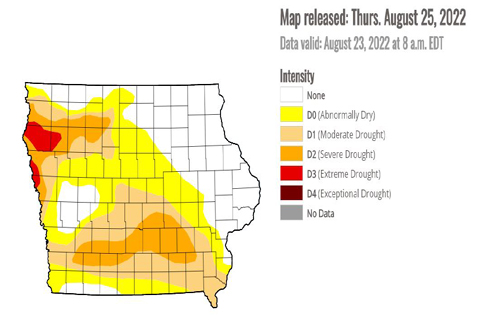By Matt Kelley (Radio Iowa)
Drought is lessening in parts of Iowa, but it’s getting worse in others. The new map detailing how drought is impacting Iowa shows slight changes from last week, with moderate drought levels rising, while severe and extreme drought levels stayed the same.
The map from the U.S. Drought Monitor shows patches of red — representing extreme drought — in five western Iowa counties: Cherokee, Monona, Plymouth, Sioux and Woodbury. Statewide, 66 counties are now in some form of drought. That’s down from 67 counties last week.
Producers are strategizing for harvest as drought can slow corn’s conversion of nitrates to essential proteins, making it potentially toxic to animals that eat corn silage or stalks. Iowa State University Extension beef specialist Chris Clark says silage goes through fermentation, which will remove more nitrates, plus, he says it’ll also replace feed for animals that farmers couldn’t get from dry pastures.
“When we’re harvesting that silage, one thing we want to do is to make sure we don’t cut it or harvest it immediately after a rain,” Clark says. “Nitrates are water soluble and often you see quite an influx of water and nitrates into the plant after a rain.”
Clark says there’s a lot more nitrates in the lower part of the cornstalk, so he recommends producers raise their choppers and leave at least a foot of the corn stalk in the field. “When you do that, you’ll get lesser yield but actually greater nutritional value on a percentage basis,” Clark says, “because we’re leaving the more un-digestible part of the plant unharvested.”
Clark recommends testing for nitrates and harvesting drought-impacted corn as corn silage instead of grain because that’ll take more nitrates out.




